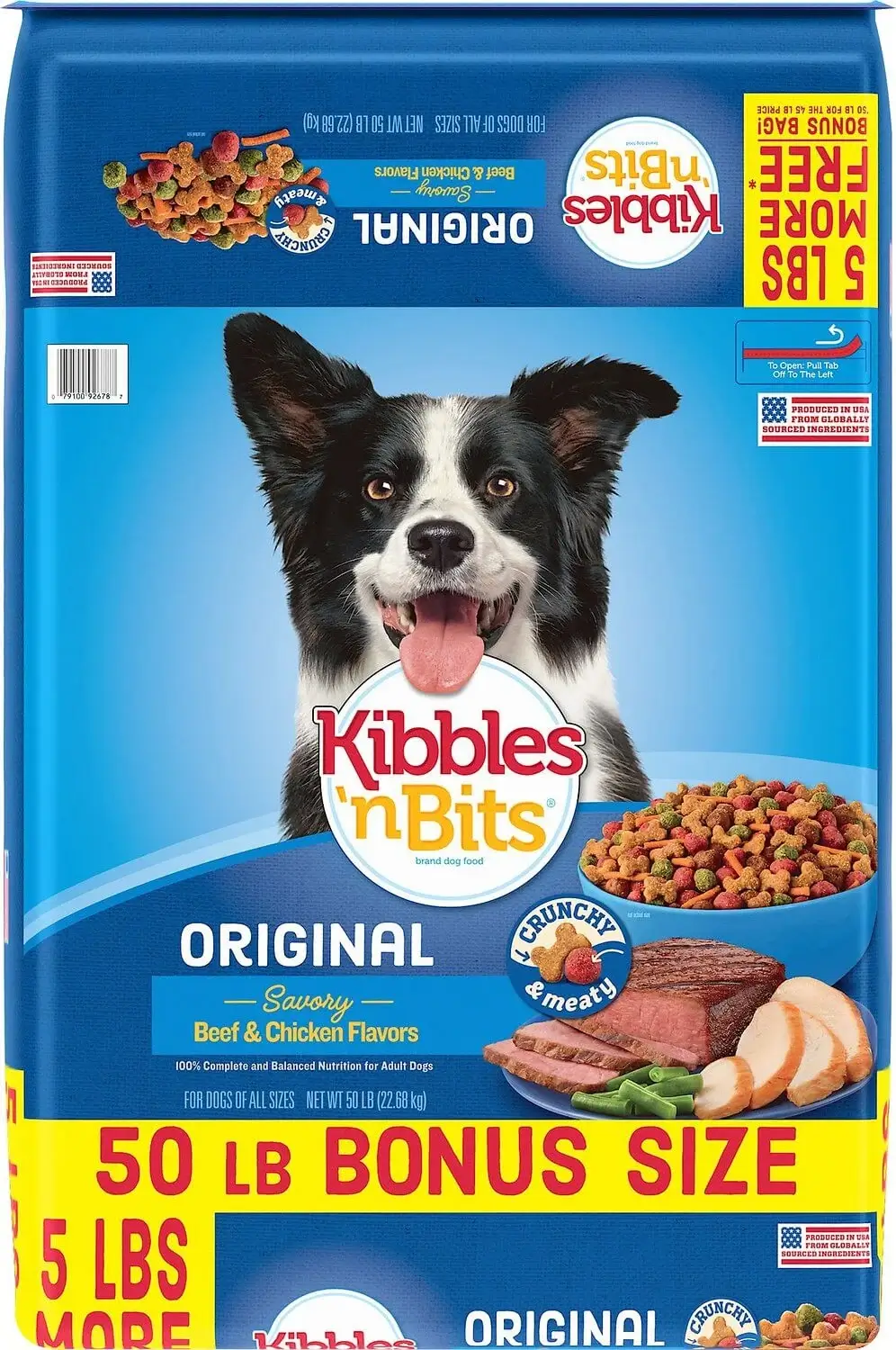
DogFoodAdvisor is reader supported See how
All reviews are 100% impartial but if you buy using links on this page, we may earn a referral fee.
Our Verdict
Kibbles ‘n Bits Dog Food product range is made up of seven recipes which each receive the Dog Food Advisor’s rating, 1 star.
Unfortunately, this is a product range made of low-quality ingredients with corn and soybean meal as the top ingredients, with meat and bone meals as the primary animal protein source.
Pros
- Budget friendly
- Small breed recipes available
- Products meet AAFCO standards
Cons
- Low quality ingredients
The table below shows each recipe in this range including our rating and the AAFCO nutrient profile: Growth (puppy), Maintenance (adult), All Life Stages, Supplemental or Unspecified.
| Product line | Rating | AAFCO |
|---|---|---|
| Kibbles ‘n Bits Bacon and Steak Flavor Mini Bits | 1 | M |
| Kibbles 'n Bits Mini Bits Small Breed | 1 | M |
| Kibbles 'n Bits Bacon and Steak Flavor | 1 | M |
| Kibbles 'n Bits Bistro Mini Bits Small Breed | 1 | M |
| Kibbles 'n Bits Bistro Oven Roasted Beef Flavor | 1 | M |
| Kibbles 'n Bits Original Savory Beef and Chicken Flavors | 1 | M |
| Kibbles ‘n Bits High Protein Triple Steak Flavor | 1 | M |
Recipe and Label Analysis
Kibbles ‘n Bits Original Savory Beef and Chicken Flavors was selected to represent the other products in the line for detailed recipe and nutrient analysis.
Kibbles 'n Bits Original Savory Beef and Chicken Flavors
Estimated Dry Matter Nutrient Content
Protein
Fat
CarbsCarbohydrates
Corn, soybean meal, beef & bone meal, whole wheat, animal fat (bha used as preservative), corn syrup, wheat middlings, water sufficient for processing, animal digest (source of chicken flavor), propylene glycol, salt, hydrochloric acid, potassium chloride, peas, caramel color, sorbic acid (used as a preservative), choline chloride, sodium carbonate, minerals (ferrous sulfate, zinc oxide, manganous oxide, copper sulfate, calcium iodate, sodium selenite), vitamins (vitamin E supplement, niacin, d-calcium pantothenate, vitamin A supplement, riboflavin supplement, thiamine mononitrate, vitamin D3 supplement, vitamin B12 supplement, pyridoxine hydrochloride, folic acid, biotin), dl-methionine, calcium sulfate, carrots, green beans, wheat flour, titanium dioxide (color), lactic acid (used as a preservative) yellow 5, yellow 6, red 40, bha (used as a preservative), blue 1
Fiber (estimated dry matter content) = 4%
Red denotes any controversial items
| Estimated Nutrient Content | |||
|---|---|---|---|
| Method | Protein | Fat | Carbs |
| Guaranteed Analysis | 19% | 8% | NA |
| Dry Matter Basis | 23% | 10% | 59% |
| Calorie Weighted Basis | 22% | 23% | 56% |
Ingredients Analysis
he first ingredient in this dog food is corn. Corn is an inexpensive and controversial cereal grain. And aside from its energy content, this grain is of only modest nutritional value to a dog.
The second ingredient is soybean meal, a by-product of soybean oil production more commonly found in farm animal feeds.
Although soybean meal contains 48% protein, this ingredient would be expected to have a lower biological value than meat.
And less costly plant-based products like this can notably boost the total protein reported on the label – a factor that must be considered when judging the actual meat content of this dog food.
The third ingredient includes an item called beef and bone meal, a dry rendered product from (beef) tissues, including bone, exclusive of blood, hair, hoof, horn, hide trimmings, manure, stomach and rumen contents”.1
Beef and bone meal may have a lower biological value than most other meat meals.
Scientists believe this decreased protein quality may be due to the ingredient’s higher ash and lower essential amino acid content.2
On the brighter side, beef and bone meals are meat concentrates and contain nearly 300% more protein than fresh meat.
In any case, beef and bone meal is not considered a better quality dog food ingredient.
The fourth ingredient is wheat. Wheat is another cereal grain and subject to the same issues as corn (previously discussed).
Next, this recipe lists animal fat. Animal fat is a generic by-product of rendering, the same high-temperature process used to make meat meals.
Since there’s no mention of a specific animal, this item could come from just about anywhere: salvaged roadkill, spoiled supermarket meat… even dead, diseased or dying cattle.
For this reason, we do not consider generic animal fat a quality ingredient.
What’s worse, this fat is preserved with BHA, a suspected cancer-causing agent.
The next ingredient is corn syrup. Corn syrup is a glucose-rich, high-calorie item of questionable nutritional value to a dog.
The seventh ingredient includes wheat middlings, commonly known as “wheat mill run”. Though it may sound wholesome, wheat mill run is actually an inexpensive by-product of cereal grain processing.
Unfortunately, the variations in nutrient content found in wheat middlings can be a critical issue in determining their suitability for use in any dog food – or even livestock feeds.3
In reality, wheat middlings are nothing more than milling dust and floor sweepings – and an ingredient more typically associated with lower quality pet foods.
The eighth ingredient is water, which adds nothing but moisture to this food. Water is a routine finding in most canned dog foods.
The ninth ingredient is animal digest. Animal digest is a chemically hydrolyzed mixture of animal by-products that is typically sprayed onto the surface of a dry kibble to improve its taste.
From here, the list goes on to include a number of other items.
But to be realistic, ingredients located this far down the list (other than nutritional supplements) are not likely to affect the overall rating of this product.
With six notable exceptions…
First, this product contains the controversial food moisturizer, propylene glycol. Propylene glycol has been banned by the FDA for use in making dog food.
However, it can still be found in some commercial dog foods.
Next, we’re always disappointed to find artificial coloring in any pet food. That’s because coloring is used to make the product more appealing to humans -not your dog. After all, do you really think your dog cares what color his food is?
This includes titanium dioxide, a white coloring agent. Although most claim the pigment to be a safe food additive, one international agency4 has classified titanium dioxide as a “Group 2B carcinogen” possibly linked to cancer in humans.
This recipe also contains caramel, a natural coloring agent made by caramelizing carbohydrates. It’s used by pet food manufacturers to impart a golden brown tint to the finished product.
However, the concentrated version of this ingredient commonly known as caramel coloring has been more recently considered controversial and found to cause cancer in laboratory animals.5
This product also contains hydrochloric acid, also known by its chemical formula, HCl. HCl is most likely used here to help prevent mold growth by making the product more acidic.
While high concentrations of any acid can be dangerous, very small amounts of low-concentration HCl can be considered safe for use in both pet and human foods.
Next, there is no mention of probiotics, friendly bacteria applied to the surface of the kibble after processing to help with digestion.
We also note that the minerals listed here do not appear to be chelated. And that can make them more difficult to absorb. Chelated minerals are usually associated with higher-quality dog foods.
And lastly, this product is preserved with BHA, a suspected cancer-causing agent.
Nutrient Analysis
Judging by its ingredients alone, Kibbles ‘n Bits Original Savory Beef and Chicken Flavors looks like a below-average dry kibble.
The dashboard displays a dry matter protein reading of 23.8%, a fat level of 10.5% and estimated carbohydrates of about 52.6%.
As a group, the brand features an average protein content of 25.5% and a mean fat level of 10.5%. Together, these figures suggest a carbohydrate content of 50.9% for the overall product line.
And a fat-to-protein ratio of about 41%.
Which means this product line contains…
Below-average protein. Below-average fat. And above-average carbs when you compare it to other dry dog foods.
When you consider the protein-boosting effect of the soybean meal and peas, this looks like the profile of a dry dog food containing a limited amount of meat.
Kibbles'n Bits Dog Food Recall History
The following automated list (if present) includes all dog food recalls related to Kibbles'n Bits through December 2025.
No recalls noted.
You can view a complete list of all dog food recalls since 2009 here.
Our Rating of Kibbles'n Bits Dry Dog Food
Kibbles ‘n Bits is a grain-inclusive dry dog food using a limited amount of named and unnamed meat meals as its main source of animal protein, thus earning the brand 1 star.
About
Compare Kibbles'n Bits Dog Food
How does Kibbles'n Bits compare with The Dog Food Advisor's most recommended brands?
Sources
A Final Word
The Dog Food Advisor does not accept money, gifts, samples or other incentives in exchange for special consideration in preparing our reviews.
However, we do receive a referral fee from online retailers (like Chewy or Amazon) and from sellers of perishable pet food when readers click over to their websites from ours. This helps cover the cost of operation of our free blog. Thanks for your support.
For more information, please visit our Disclaimer and Disclosure page.








